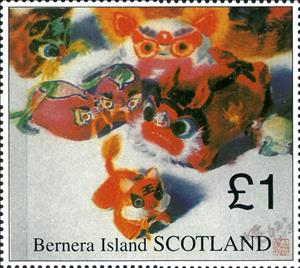Stamp: 1998 year of the Tiger (Scotland, Bernera Island 1998)
1998 year of the Tiger (Scotland, Bernera Island 1998)
01 January (Scotland, Bernera Island ) within release Chinese zodiac 1998 goes into circulation Stamp 1998 year of the Tiger face value 1 British pound sterling
| Stamp 1998 year of the Tiger in catalogues | |
|---|---|
| Colnect codes: | Col: GB-BI 1998-06/1 |
Stamp is square format.
Bernera Island or simply Bernera is a tidal island off Lismore, in Argyll, Scotland. Bernera labels were originally made for and approved by the owner of the island, Count Robin de la Lanne-Mirrlees, who owned the island until 2012 upon his passing. The printer of those is unknown. These original issues stopped in 1978 which can be recognized by the Bernera flag imprinted on them. Clive Feigenbaum (with permission of the laird) began making bogus labels in 1978 in the name of Bernera and continued to produce them through 2000. Only a few have the Bernera flag imprinted on them and not in the same way as the older labels. Several sets (Locomotives and Automobiles) were printed by the Format International Security Printers due to Feigenbaum's influence with certain owners at the time and his eventual ownership of the company which ended in the company going bankrupt in 1990. Bernera has easy access to the mainland postal services over a bridge built in 1953 and has never needed local stamps that are used under the rules of what British Local stamp issues are used for. Feigenbaum continued to produce hundreds of bogus labels in the name of Bernera and distribute them to the philatelic market as if they were real British Locals. Many want to call them Cinderella stamps to legitimize and sell them when in reality they are bogus labels created for personal profits. They are not genuine British locals (as some claim) like Lundy Island stamps. Bogus catalogs have even been made to legitimize them. These labels in the name of Bernera were used in a tax shelter scheme in which the defendants were convicted.Stamp 1998 year of the Tiger it reflects the thematic directions:
Animals are multicellular, eukaryotic organisms of the kingdom Animalia (also called Metazoa). All animals are motile, meaning they can move spontaneously and independently, at some point in their lives. Their body plan eventually becomes fixed as they develop, although some undergo a process of metamorphosis later on in their lives. All animals are heterotrophs: they must ingest other organisms or their products for sustenance.
Chinese New Year or the Spring Festival (see also § Names) is a festival that celebrates the beginning of a new year on the traditional lunisolar Chinese calendar. Marking the end of winter and the beginning of spring, observances traditionally take place from Chinese New Year's Eve, the evening preceding the first day of the year, to the Lantern Festival, held on the 15th day of the year. The first day of Chinese New Year begins on the new moon that appears between 21 January and 20 February
Mammals are any vertebrates within the class Mammalia (/məˈmeɪli.ə/ from Latin mamma "breast"), a clade of endothermic amniotes distinguished from reptiles (including birds) by the possession of a neocortex (a region of the brain), hair, three middle ear bones and mammary glands. All female mammals nurse their young with milk, secreted from the mammary glands. Mammals include the largest animals on the planet, the great whales. The basic body type is a terrestrial quadruped, but some mammals are adapted for life at sea, in the air, in trees, underground or on two legs. The largest group of mammals, the placentals, have a placenta, which enables the feeding of the fetus during gestation. Mammals range in size from the 30–40 mm (1.2–1.6 in) bumblebee bat to the 30-meter (98 ft) blue whale. With the exception of the five species of monotreme (egg-laying mammals), all modern mammals give birth to live young. Most mammals, including the six most species-rich orders, belong to the placental group. The largest orders are the rodents, bats and Soricomorpha (shrews and allies). The next three biggest orders, depending on the biological classification scheme used, are the Primates (apes and monkeys), the Cetartiodactyla (whales and even-toed ungulates), and the Carnivora (cats, dogs, seals, and allies).
The tiger (Panthera tigris) is a member of the genus Panthera and the largest living cat species native to Asia. It has a powerful, muscular body with a large head and paws, a long tail and orange fur with black, mostly vertical stripes. It is traditionally classified into nine recent subspecies, though some recognise only two subspecies, mainland Asian tigers and the island tigers of the Sunda Islands.
The zodiac is a belt-shaped region of the sky that extends approximately 8° north and south (as measured in celestial latitude) of the ecliptic, the apparent path of the Sun across the celestial sphere over the course of the year. Also within this zodiac belt appear the Moon and the brightest planets, along their orbital planes. The zodiac is divided along the ecliptic into 12 equal parts ("signs"), each occupying 30° of celestial longitude. These signs roughly correspond to the astronomical constellations with the following modern names: Aries, Taurus, Gemini, Cancer, Leo, Virgo, Libra, Scorpio, Sagittarius, Capricorn, Aquarius, and Pisces.







